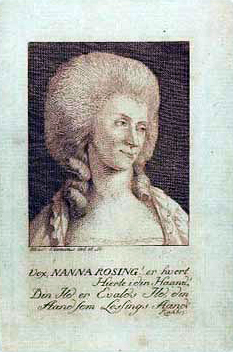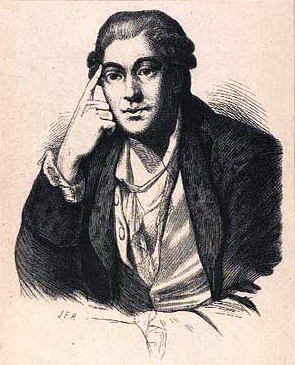Related Research Articles

Caspar Frederik (Friedrich) Harsdorff, also known as C.F. Harsdorff, was a Danish neoclassical architect considered to have been the leading Danish architect in the late 18th century.

Christiania Theatre, or Kristiania Theatre, was Norway's finest stage for spoken drama from 4 October 1836 to 1 September 1899. It was located at Bankplassen by the Akershus Fortress, in central Christiania. It was the first lasting public theatre in Norway and the national stage of Norway and Oslo during the 19th century.

Caroline Frederikke Müller née Halle also known as Caroline Walther, was a Danish and later naturalized Swedish opera singer (mezzo-soprano). She was also active as an instructor at the Royal Dramatic Training Academy. She was a member of the Royal Swedish Academy of Music and a Hovsångare.

Det Ny Teater is an established theatre in Copenhagen, Denmark, first opened in 1908. It is based in a building which spans a passage between Vesterbrogade and Gammel Kongevej in Copenhagen's theatre district on the border between Vesterbro and Frederiksberg.

Mette Marie Astrup was a Danish actress, one of the best known of her time in Denmark. She enjoyed a career totaling fifty years at the Royal Danish Theatre in Copenhagen.
Det Dramatiske Selskab is the name for several Norwegian amateur theatre drama troupes. These troupes were the first permanent theatre troupes in the cities of Norway. The period between 1780–1830 is described by many as the age of the dramatic companies.
Martin Nürenbach or Nurembach was a German acrobat, stage actor, dancer and equilibrist active in Sweden, Norway and Finland. He was a pioneer in Norwegian theater history by founding the first public theater in Oslo in the year 1771.
The Royal Norwegian Society of Sciences and Letters is a Norwegian learned society based in Trondheim. It was founded in 1760 and is Norway's oldest scientific and scholarly institution. The society's Protector is King Harald V of Norway. Its membership consists of no more than 435 members elected for life among the country's most prominent scholars and scientists.

Johan Peter Strömberg was a Swedish stage actor, dancer and theatre director. He was the founder of the first public theatre and acting school in Oslo, Norway.
Christina Doreothea Stuart, known under her stage name Madame Stuart, was a dancer, equilibrist, singer and musician active in Norway. She played an important part in Norwegian cultural history; she is noted as a pioneer figure of ballet in Norway and connected to the activity of the first public theater in Norway. She is considered to be the first ballet dancer to perform in Oslo and Norway.

Johanne Cathrine Rosing, née Olsen, was a Danish stage actress and ballet dancer, one of the most noted of the era.
Events from the year 1777 in Denmark.
Michael Treschow was a Danish Supreme Court justice and prefect of Roskilde County who was ennobled by letter patent in 1812. He was the father of Frederik Treschow.

Cathrine Marie Gielstrup née Morell was a Danish stage actress. She was active at the Royal Danish Theatre in 1773–1792, and a member of the Det Dramatiske Selskab in 1777-79.

Frederik Schwarz (1753-1838) was a Danish actor. He was an elite actor of the Royal Danish Theatre from 1773 to 1810. He played roles in both comedy and tragedy and had a great impact on the contemporary acting tradition in Denmark when forming the new organisation of the theater, as the founder and manager of the Det Dramatiske Selskab from 1775 to 1778 and as the theater's acting instructor from 1779 to 1816.

Michael Rosing was a Norwegian-Danish actor.
Christiania Offentlige Theater or Det Strømbergske Teater was a historic theatre in Oslo in Norway, active between 1827 and 1835. It was the first public theatre in Oslo and in Norway, and the predecessor of the Christiania Theatre.
Johan Conrad Huusher (1797–1869) was a Norwegian-Danish actor and theatre director.

A Meeting in the Royal Danish Academy of Sciences and Letters is a monumental 1897 oil-on-canvas group portrait painting by Peder Severin Krøyer, depicting the membership of Royal Danish Academy of Sciences and Letters during one of its meetings in the Prince's Mansion in Copenhagen. The painting was commissioned by the Carlsberg Foundation in conjunction with the construction of its new building on H. C. Andersens Boulevard. Measuring 519.4 cm (204.5 in) wide and 266.7 cm (105.0 in) tall, it is Krøyer's largest painting.

Hedevig Faaborg Quiding née Springborg was a Danish operatic soprano, voice instructor and music critic. When she was 19, she made her debut at the Royal Danish Opera as Philine in Ambroise Thomas' Mignon but then moved to Germany where over the next ten years she performed some 40 roles in the opera houses of Berlin, Munich and Nuremberg. On returning to Denmark, from the turn of the century she retired from the stage to become an effective voice and stagecraft instructor and from the 1920s an influential music critic. In later years, she concentrated on writing and on making radio broadcasts.
References
- Jørgensen, L Frederik Schwarz – Den tænkende Kunstner 1997.
- Dansk biografisk Lexikon / XV. Bind. Scalabrini - Skanke